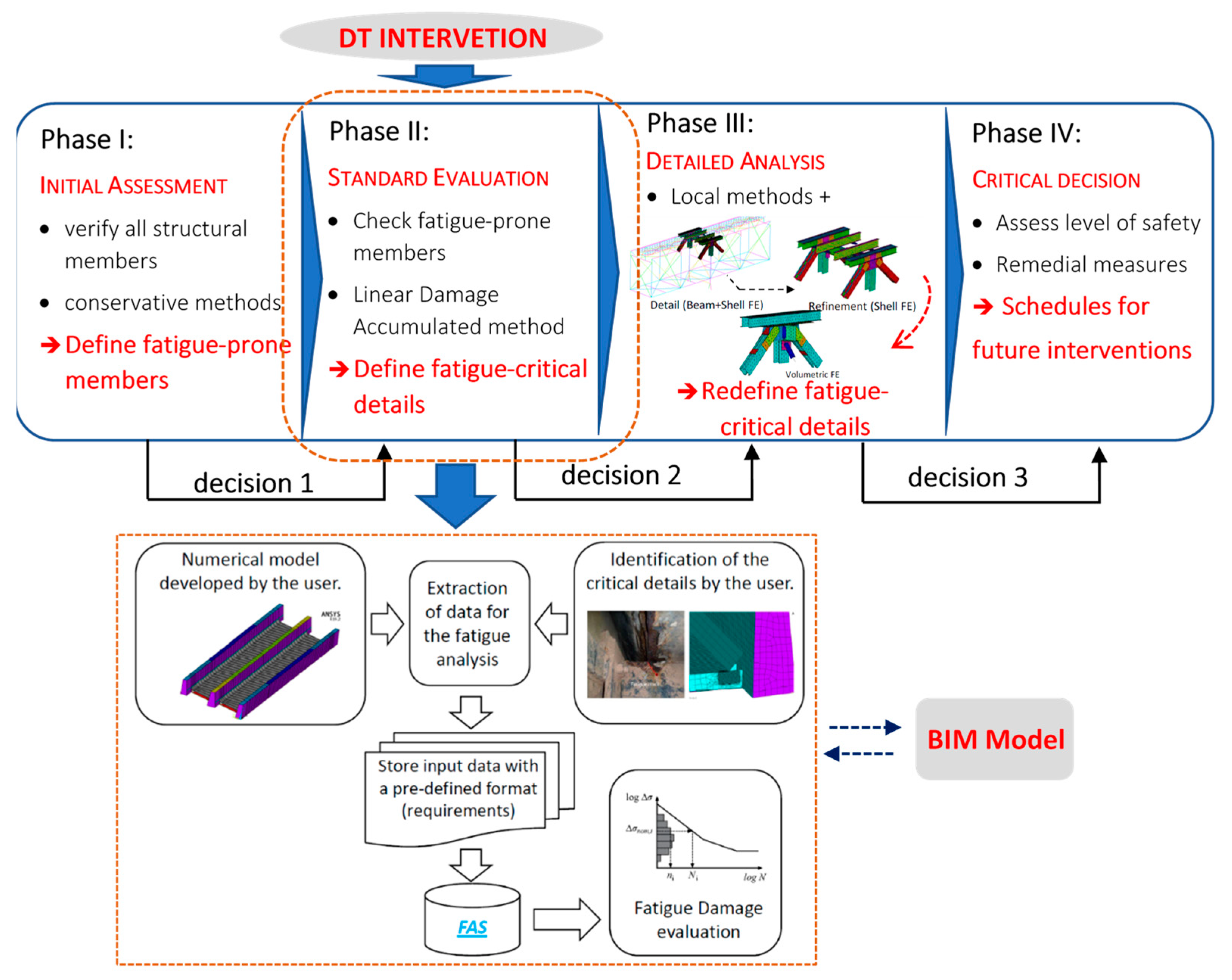Performing Fatigue State Characterization in Railway Steel Bridges Using Digital Twin Models
Abstract
1. Introduction
- -
- Quick mapping of the condition of the connection details regarding the fatigue evolution;
- -
- “What if scenarios” to quickly evaluate various scenarios affecting fatigue evolution.
2. Fatigue Analysis System (FAS)
- The Equivalent Constant Amplitude Stress Range Method (ECASRM) (also known as λ-coefficient method): the method is significantly simplified as it does not consider variation in stress amplitude and is suitable for evaluations under quasi-static effects when dynamic analyses are not necessary, considering the applicable load models defined in EC1-2 [28]. Safety is considered satisfied when the conditions expressed by the inequalities (1) and (2) below are verified:
- 2.
- Linear Damage Accumulation Method (LDAM) (also known as Palmgren-Miner rule): the most comprehensive method provided by the Eurocodes and has been widely used in several research projects. Both quasi-static and dynamic analyses can be associated with actual or normative traffic for fatigue specified in EC1-2 [28]. To assess safety, the accumulation of partial fatigue damage corresponding to stress amplitudes generated from a given stress history is computed (Equation (4)).
3. Approach to the Proposed Digital Twin Model
3.1. Data Scheme for the Proposed Digital Twin Model
- Create parameters in the BIM platform to (a) choose a particular type of traffic for analysis and (b) introduce geometry properties data to update the numerical model;
- Implement a routine in a visual programming DYNAMO to extract the data mentioned above and forward it to FAS;
- Create new routines based on MATLAB® v2021a and APDL in the previously created FAS so that the system can receive new data, be updated (including the FEM), and issue new results.
3.2. Integrated Data-Flow Process for Fatigue Damage Representation and Simulation
- (a)
- The FAS produces the accumulated damage in the different details, the location of the respective details, and the associated traffic. These data and other relevant data from the FAS are forwarded for representation in the BIM model.
- (b)
- The information introduced by the user in the BIM platform to update the FAS (FEM and other variables of the fatigue resistance module).
4. Bridge Case Study
4.1. Description of the Bridge
4.2. Fatigue Analysis System Implementation
4.3. Bridge BIM Model
4.4. Integrated Model: Sample Representation of Fatigue State
5. Conclusions
- Development of a data flow scheme for interaction between the FAS and BIM model for fatigue evolution representation and visualization;
- Creation of an open system that allows inputs related to various traffic conditions and geometric properties, resulting in an automatic representation of fatigue evolution;
- Flexibilization in global fatigue evaluation through automatic mapping of fatigue evolution, allowing for a quick decision-making process regarding the need or not for advanced local analysis or inspection levels to be implemented.
Author Contributions
Funding
Institutional Review Board Statement
Informed Consent Statement
Data Availability Statement
Acknowledgments
Conflicts of Interest
References
- Horas, C.S.; De Jesus, A.M.; Calçada, R. New multiphase methodology for fatigue damage screening of aging metallic railway bridges. Int. J. Fatigue 2023, 169, 107498. [Google Scholar] [CrossRef]
- Haghani, R.; Al-Emrani, M.; Heshmati, M. Fatigue-Prone Details in Steel Bridges. Buildings 2012, 2, 456–476. [Google Scholar] [CrossRef]
- Jiang, F.; Ding, Y.; Song, Y.; Geng, F.; Wang, Z. Digital Twin-driven framework for fatigue life prediction of steel bridges using a probabilistic multiscale model: Application to segmental orthotropic steel deck specimen. Eng. Struct. 2021, 241, 112461. [Google Scholar] [CrossRef]
- Jiang, F.; Ding, Y.; Song, Y.; Geng, F.; Wang, F. An architecture of lifecycle fatigue management of steel bridges driven by Digital Twin. Struct. Monit. Maint. 2021, 8, 187–201. [Google Scholar] [CrossRef]
- Horas, C.S.; De Jesus, A.M.; Calçada, R. Efficient progressive global-local fatigue assessment methodology for existing metallic railway bridges. J. Constr. Steel Res. 2022, 196, 107431. [Google Scholar] [CrossRef]
- Zhang, Y.; Zheng, K.; Heng, J.; Zhu, J. Corrosion-Fatigue Evaluation of Uncoated Weathering Steel Bridges. Appl. Sci. 2019, 9, 3461. [Google Scholar] [CrossRef]
- CEN. Eurocode 3: Design of Steel Structures, Part 1–9: Fatigue; Instituto Português da Qualidade (IPQ): Lisbon, Portugal, 2010. [Google Scholar]
- Errandonea, I.; Beltrán, S.; Arrizabalaga, S. Digital Twin for maintenance: A literature review. Comput. Ind. 2020, 123, 103316. [Google Scholar] [CrossRef]
- Naderi, H.; Shojaei, A. Digital twinning of civil infrastructures: Current state of model architectures, interoperability solutions, and future prospects. Autom. Constr. 2023, 149, 104785. [Google Scholar] [CrossRef]
- Honghong, S.; Gang, Y.; Haijiang, L.; Tian, Z.; Annan, J. Digital twin enhanced BIM to shape full life cycle digital transformation for bridge engineering. Autom. Constr. 2023, 147, 104736. [Google Scholar] [CrossRef]
- Boje, C.; Guerriero, A.; Kubicki, S.; Rezgui, Y. Towards a semantic Construction Digital Twin: Directions for future research. Autom. Constr. 2020, 114, 103179. [Google Scholar] [CrossRef]
- Jiang, F.; Ma, L.; Broyd, T.; Chen, K. Digital twin and its implementations in the civil engineering sector. Autom. Constr. 2021, 130, 103838. [Google Scholar] [CrossRef]
- Gao, Y.; Qian, S.; Li, Z.; Wang, P.; Wang, F.; He, Q. Digital Twin and Its Application in Transportation Infrastructure. In Proceedings of the 2021 IEEE 1st International Conference on Digital Twins and Parallel Intelligence (DTPI), Beijing, China, 15 July–15 August 2021. [Google Scholar]
- Pan, Y.; Zhang, L. A BIM-data mining integrated digital twin framework for advanced project management. Autom. Constr. 2021, 124, 103564. [Google Scholar] [CrossRef]
- Grieves, M. Digital twin: Manufacturing excellence through virtual factory replication. White Pap. 2014, 1, 1–7. [Google Scholar]
- Ye, C.; Butler, L.; Bartek, C.; Iangurazov, M.; Lu, Q.; Gregory, A.; Girolami, C. A Digital Twin of Bridges for Structural Health Monitoring. In Proceedings of the 12th International Workshop on Structural Health Monitoring 2019, Stanford, CA, USA, 10–12 September 2019; DEStech Publications, Inc.: Lancaster, UK. [Google Scholar]
- Wenner, M.; Meyer-Westphal, M.; Herbrand, M.; Ullerich, C. The concept of digital twin to revolutionise infrastructure maintenance: The pilot project smartBRIDGE Hamburg. In Proceedings of the 27th ITS world congress, Hamburg, Germany, 11–15 October 2021. [Google Scholar]
- Qi, Q.; Tao, F.; Hu, T.; Anwer, N.; Liu, A.; Wei, Y.; Wang, L.; Nee, A. Enabling technologies and tools for digital twin. J. Manuf. Syst. 2019, 58, 3–21. [Google Scholar] [CrossRef]
- Dang, N.; Shim, C. Bridge assessment for PSC Girder Bridge using Digital Twins Model. In CIGOS 2019, Innovation for Sustainable Infrastructure. Lecture Notes in Civil Engineering, vol 54; Springer: Singapore, 2020; pp. 1241–1246. [Google Scholar] [CrossRef]
- Shim, C.-S.; Dang, N.-S.; Lon, S.; Jeon, C.-H. Development of a bridge maintenance system for prestressed concrete bridges using 3D digital twin model. Struct. Infrastruct. Eng. 2019, 15, 1319–1332. [Google Scholar] [CrossRef]
- Kaewunruen, S.; Sresakoolchai, J.; Ma, W.; Phil-Ebosie, O. Digital Twin Aided Vulnerability Assessment and Risk-Based Maintenance Planning of Bridge Infrastructures Exposed to Extreme Conditions. Sustainability 2021, 13, 2051. [Google Scholar] [CrossRef]
- Kaewunruen, S.; AbdelHadi, M.; Kongpuang, M.; Pansuk, W.; Remennikov, A.M. Digital Twins for Managing Railway Bridge Maintenance, Resilience, and Climate Change Adaptation. Sensors 2022, 23, 252. [Google Scholar] [CrossRef]
- Tao, F.; Xiao, B.; Qi, Q.; Cheng, J.; Ji, P. Digital twin modeling. J. Manuf. Syst. 2022, 64, 372–389. [Google Scholar] [CrossRef]
- Yu, S.; Li, D.; Ou, J. Digital twin-based structure health hybrid monitoring and fatigue evaluation of orthotropic steel deck in cable-stayed bridge. Struct. Control. Heal. Monit. 2022, 29, e2976. [Google Scholar] [CrossRef]
- Ye, X.W.; Su, Y.H.; Han, J.P. A State-of-the-Art Review on Fatigue Life Assessment of Steel Bridges. Math. Probl. Eng. 2014, 2014, 1–13. [Google Scholar] [CrossRef]
- Horas, C.S. Integrated Methodology for Fatigue Life Prediction of Existing Metallic Railway Bridges; Faculty of Engineering, University of Porto: Porto, Portugal, 2021. [Google Scholar]
- Bannantine, J.A.; Handrock, J.L.; Comer, J.J. Fundamentals of Metal Fatigue Analysis; Prentice Hall: Hoboken, NJ, USA, 1990. [Google Scholar]
- CEN. Eurocode 1: Actions on structures. Part 2: Traffic Loads on Bridges; European Committee for Standardization (CEN): Brussels, Belgium, 2003. [Google Scholar]
- Horas, C.S.; De Jesus, A.M.P.; Calçada, R. Integrated Methodology for Fatigue Assessment of Existing Metallic Railway Bridges. In Proceedings of the Fifth International Conference on Railway Technology: Research, Development and Maintenance, Montpellier, France, 22–25 August 2022. [Google Scholar]
- Dang, N.-S.; Rho, G.-T.; Shim, C.-S. A Master Digital Model for Suspension Bridges. Appl. Sci. 2020, 10, 7666. [Google Scholar] [CrossRef]
- ANSYS, I. ANSYS Mechanical APDL Element Reference; ANSYS Inc.: Canonsburg, PA, USA, 2017. [Google Scholar]
- Horas, C.S.; De Jesus, A.M.; Ribeiro, D.; Calçada, R. Efficient multiscale methodology for local stress analysis of metallic railway bridges based on modal superposition principles. Eng. Fail. Anal. 2022, 138, 106391. [Google Scholar] [CrossRef]

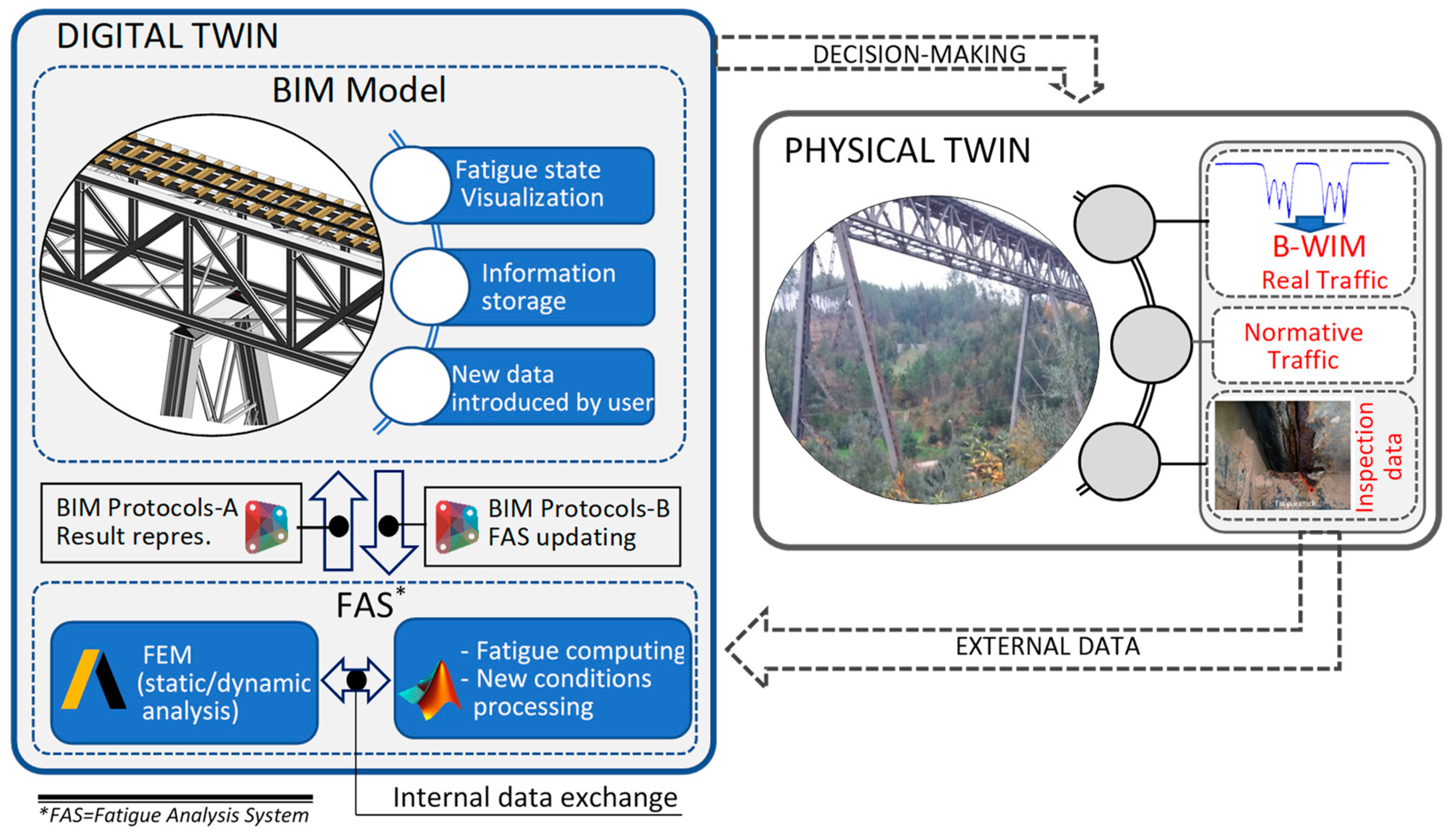
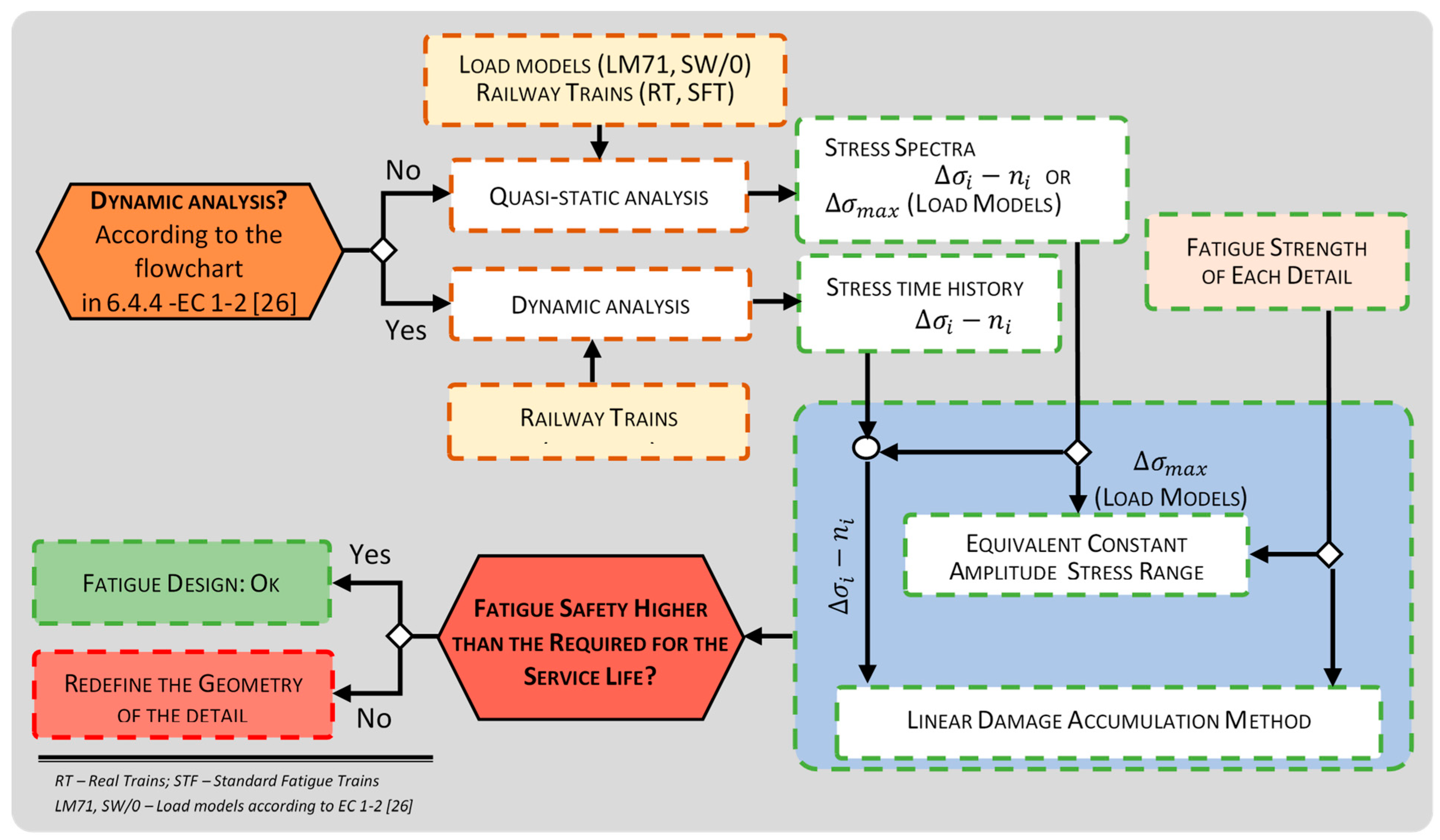
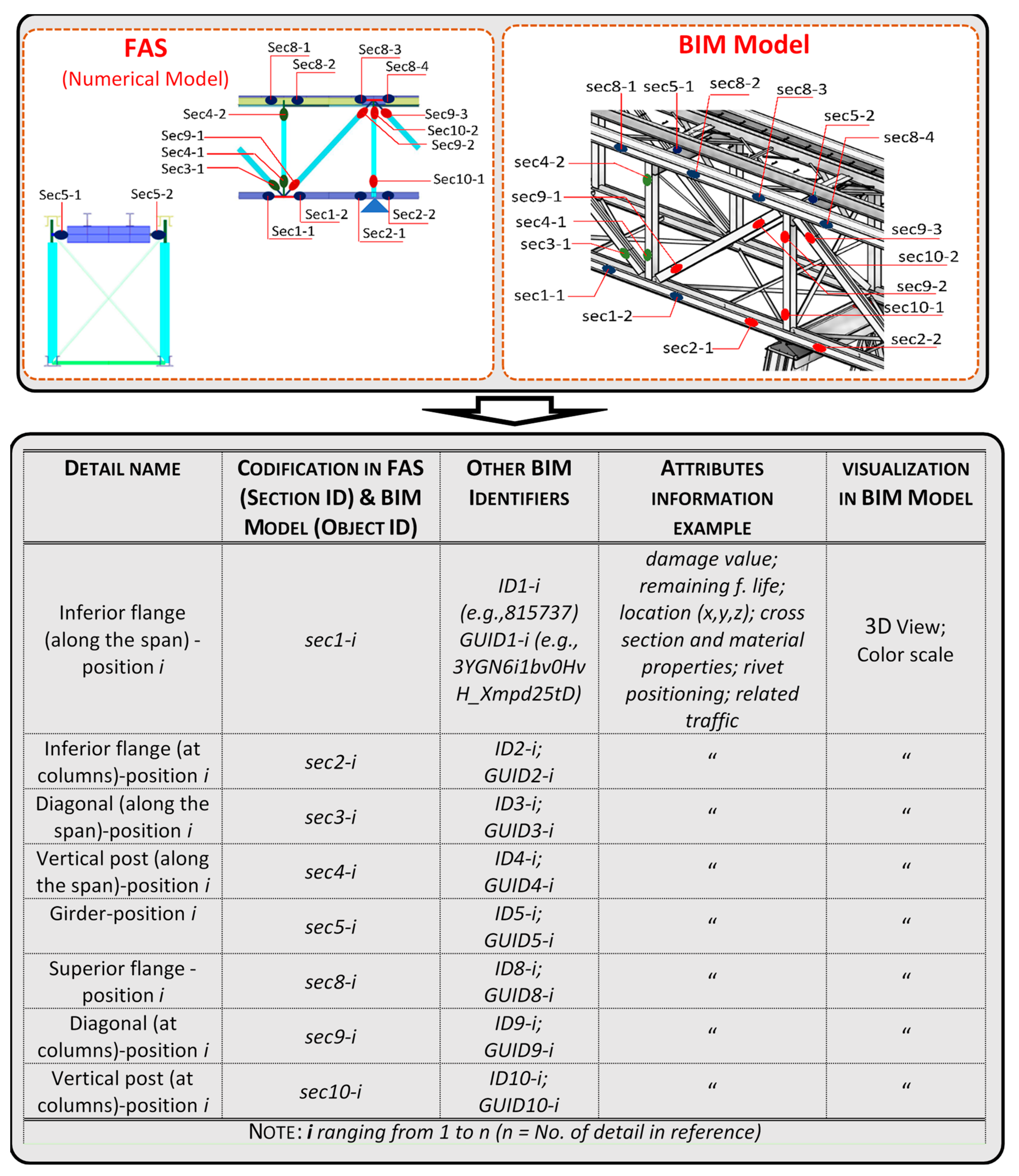
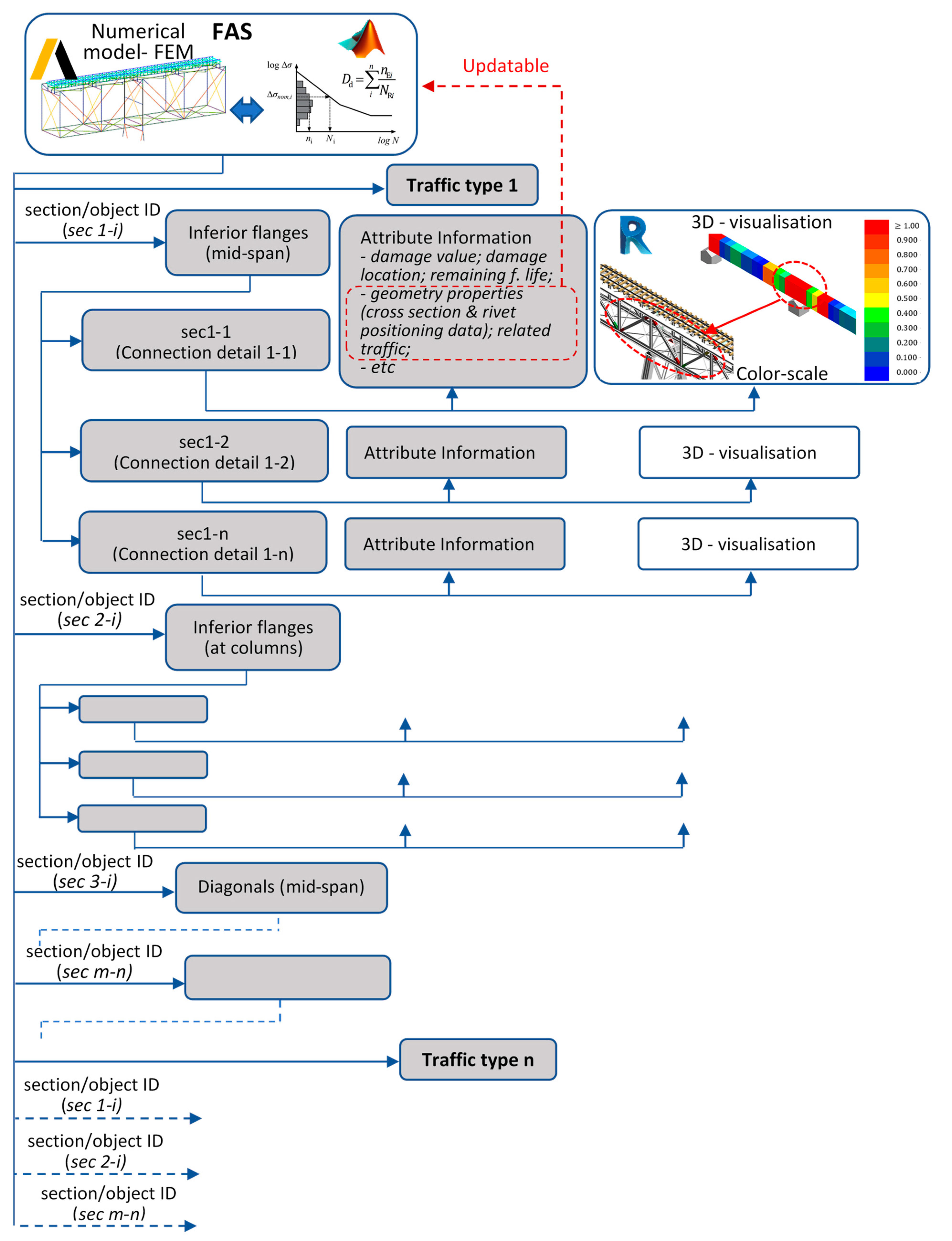
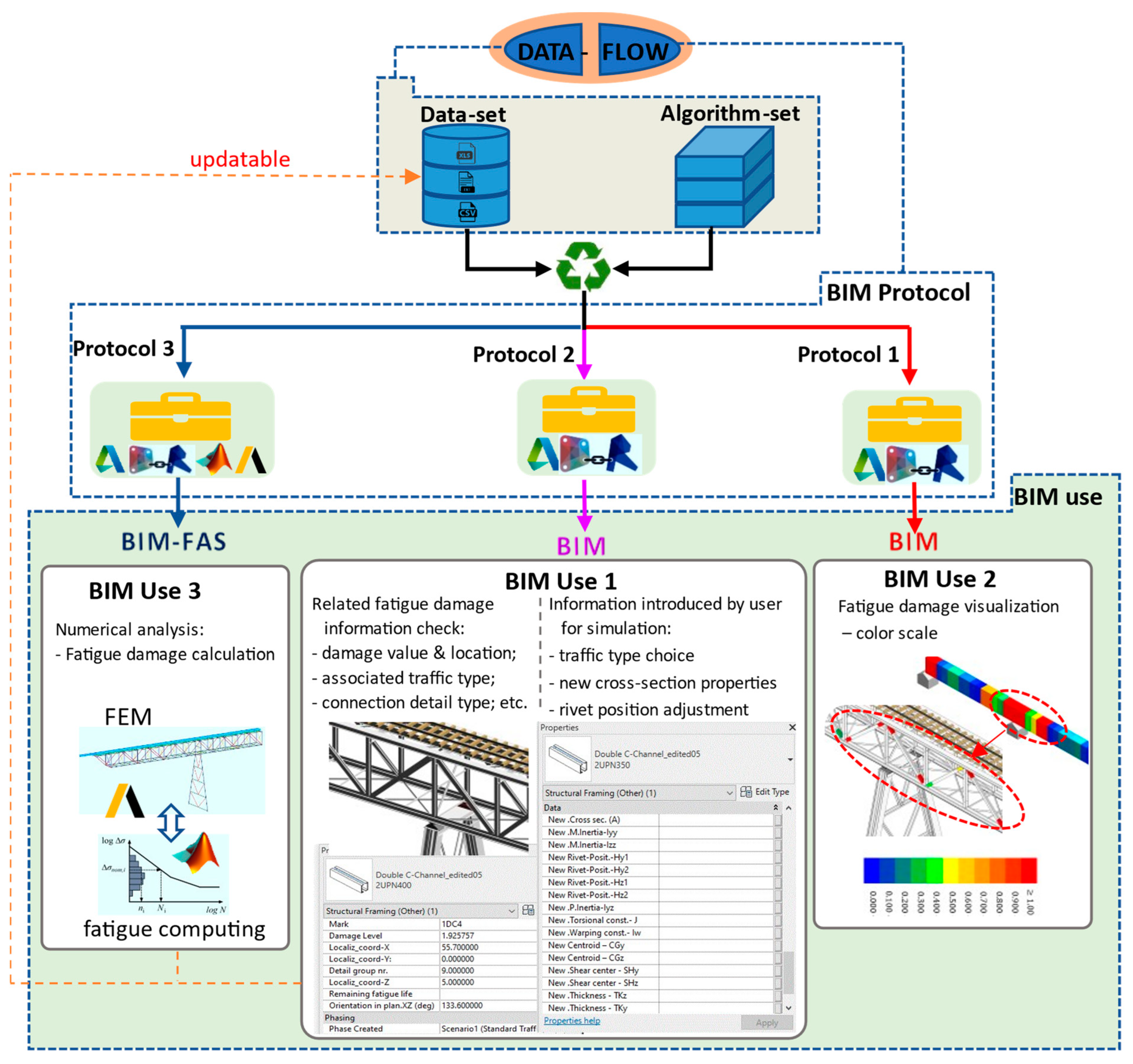
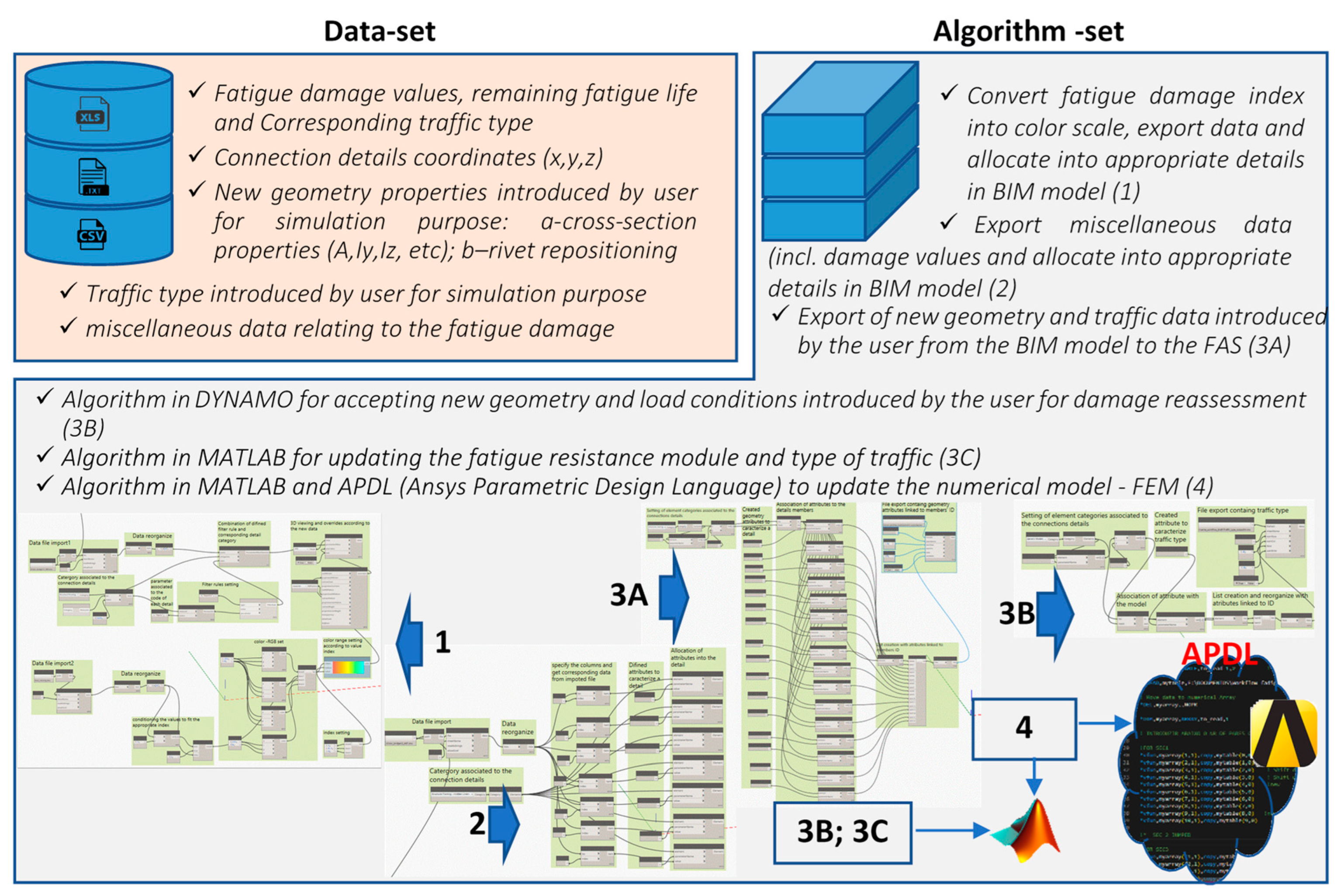
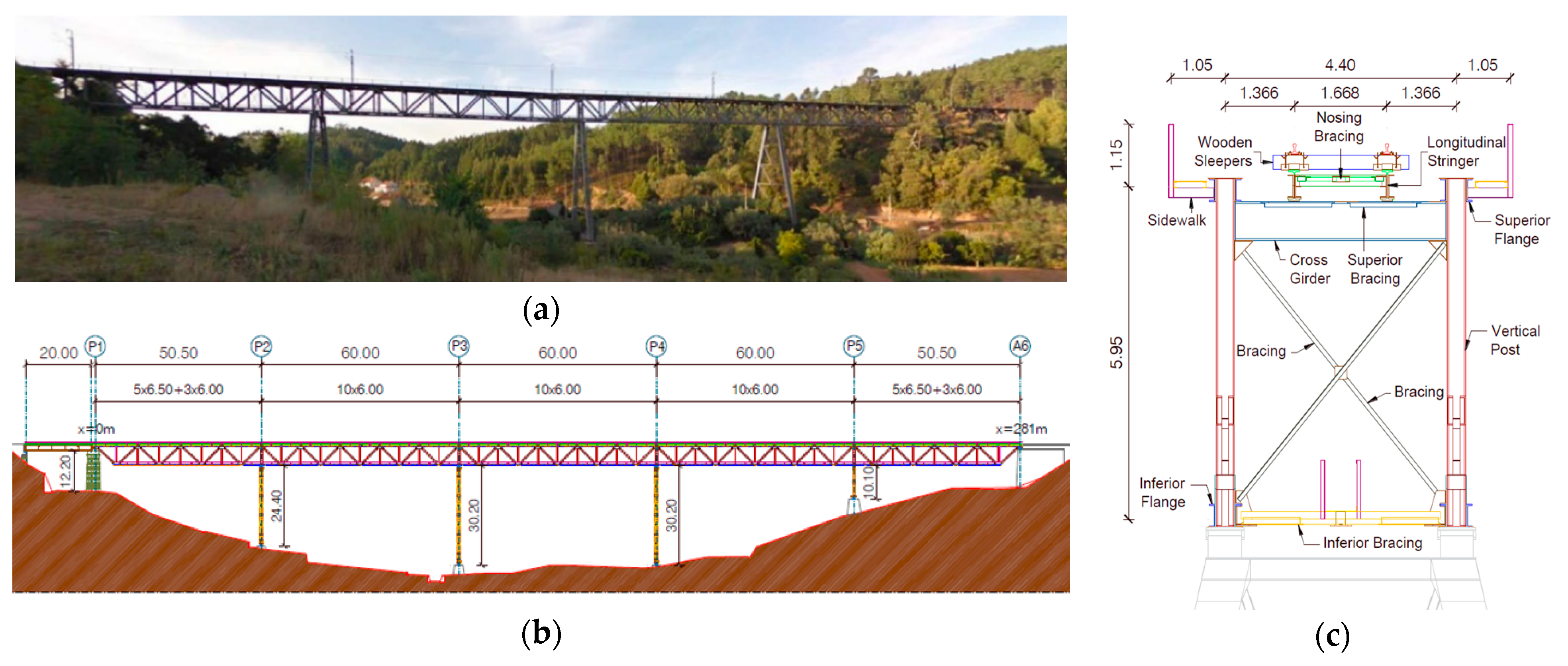
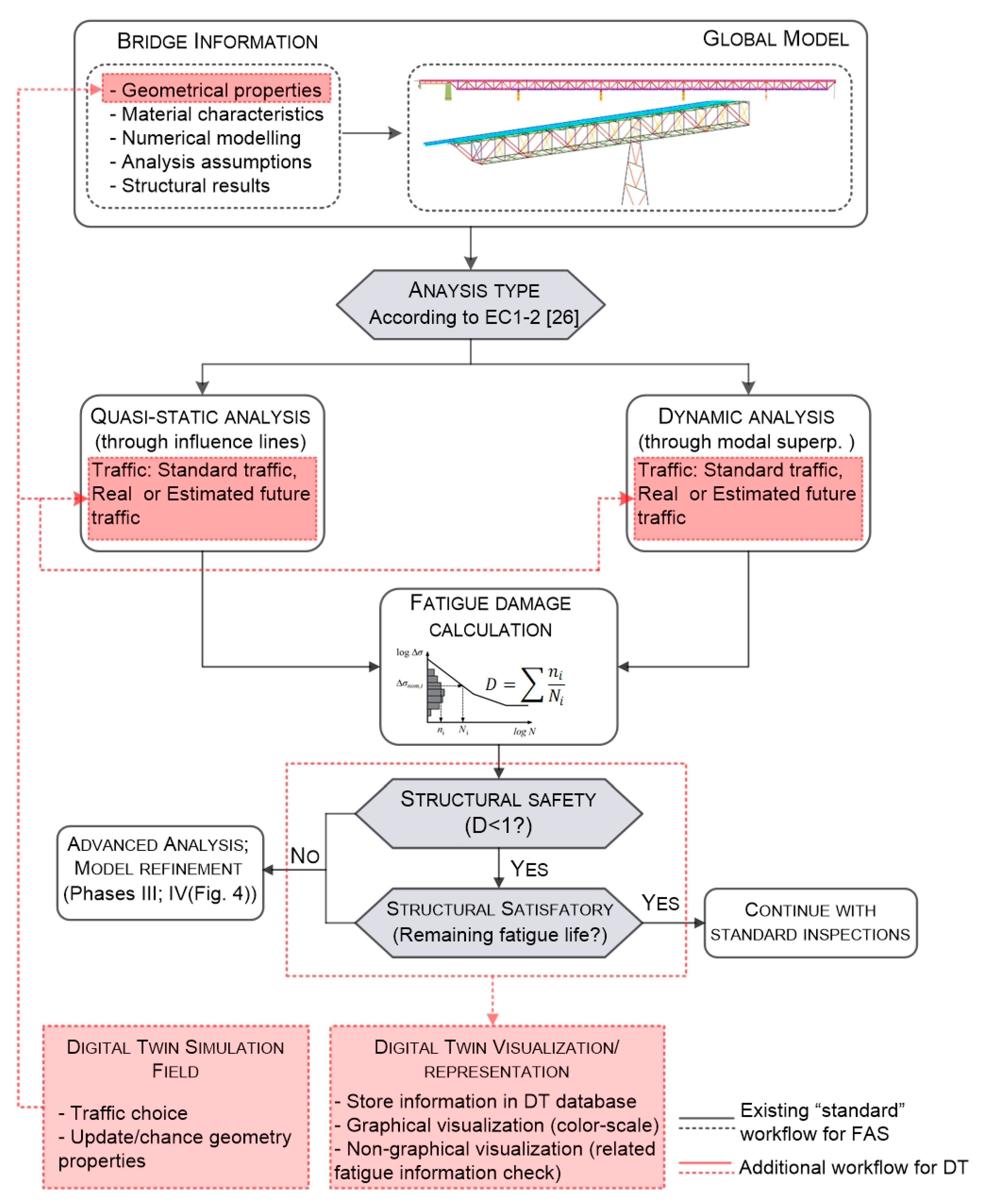
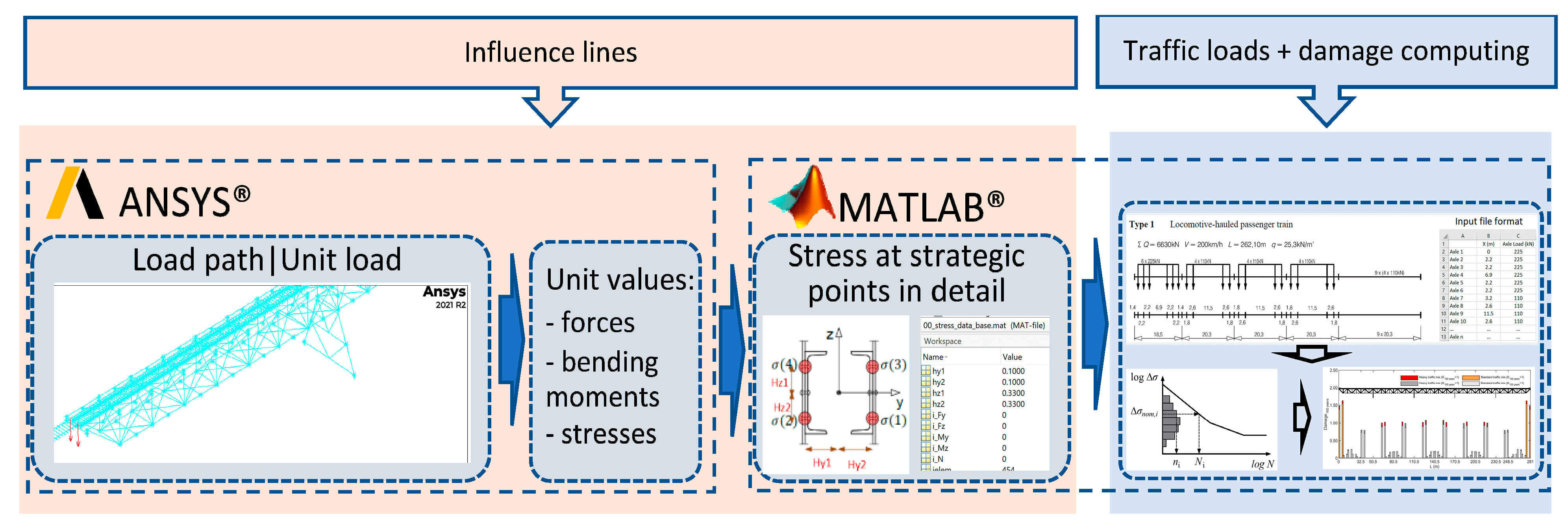
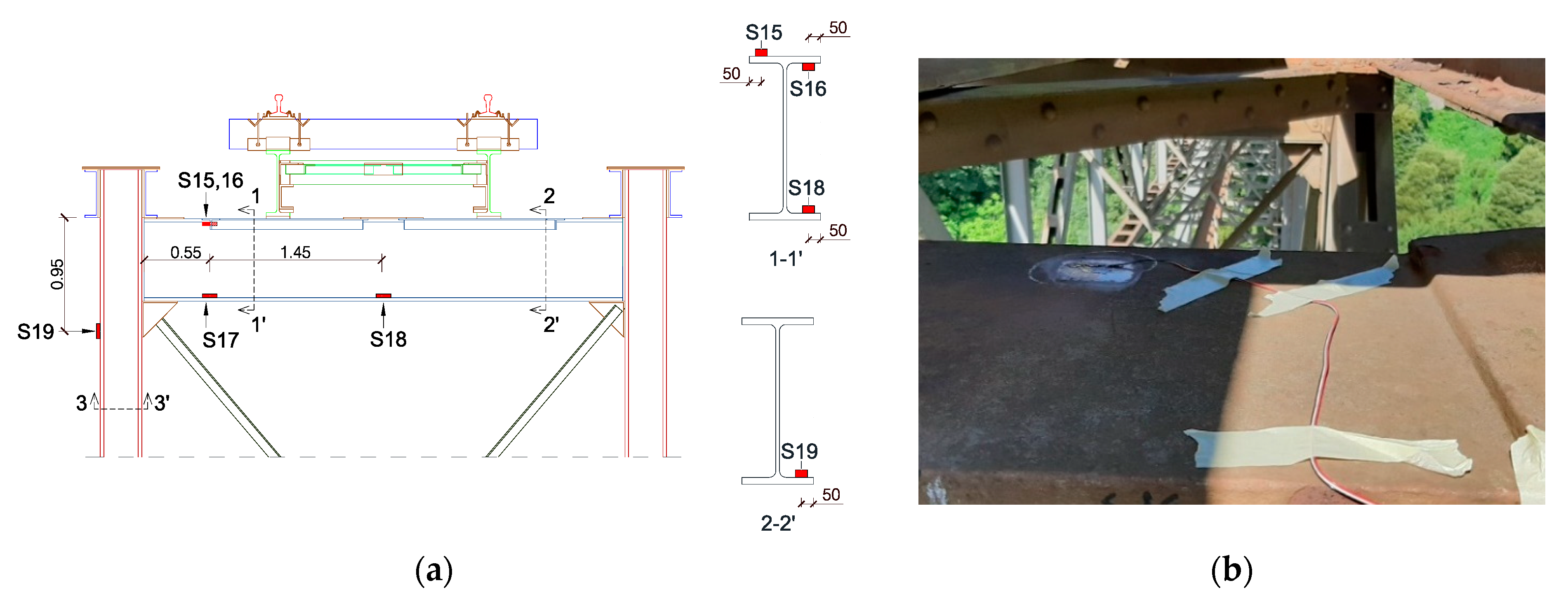
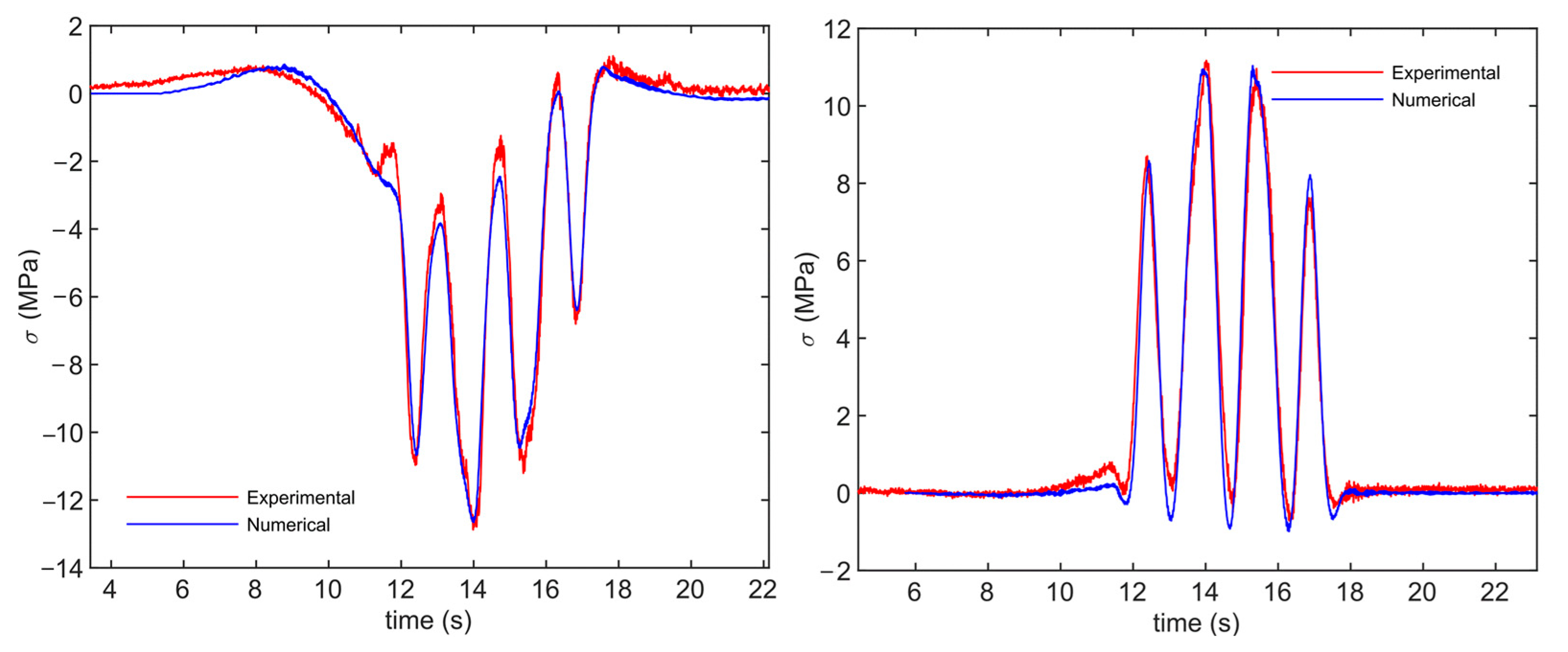

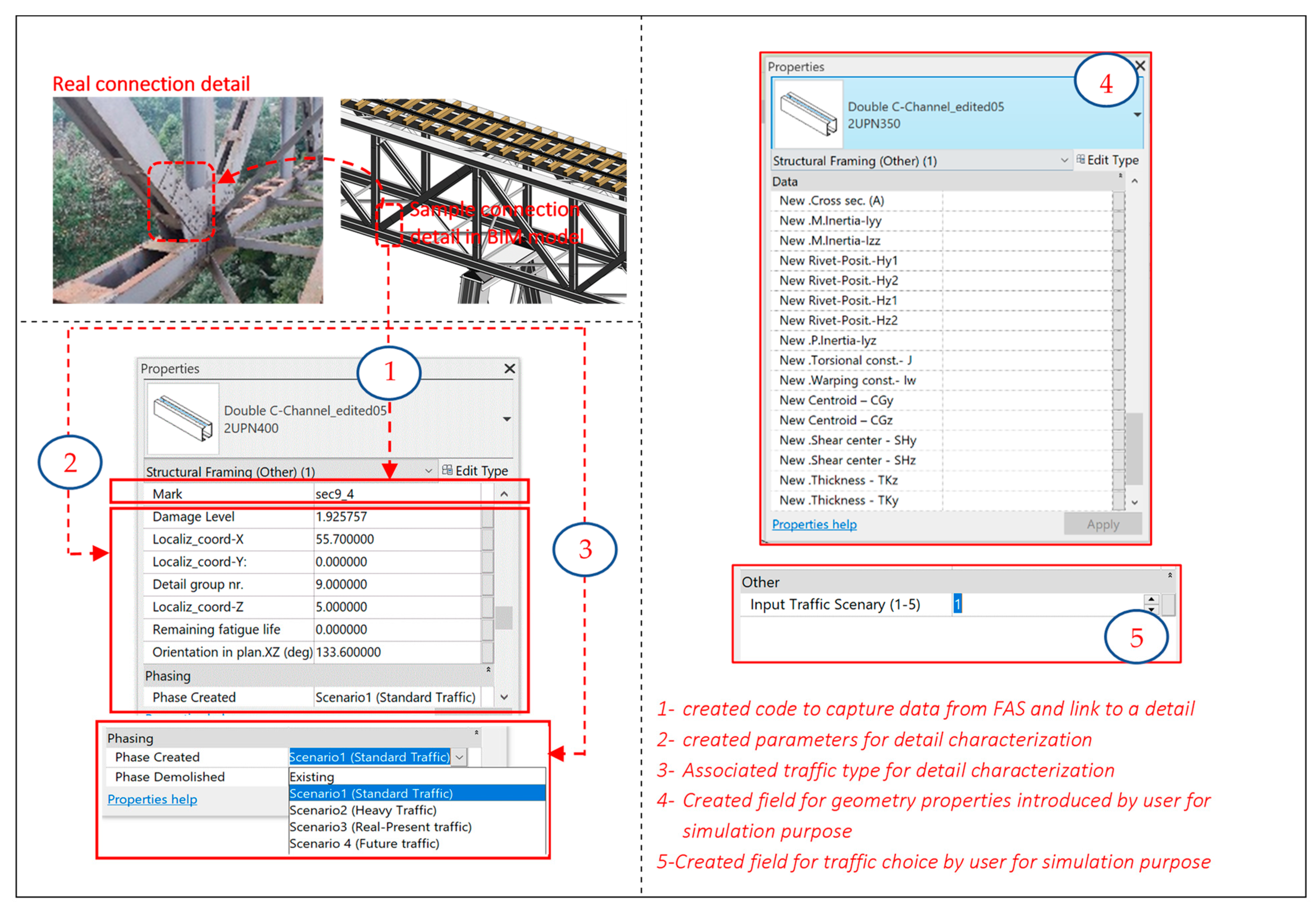
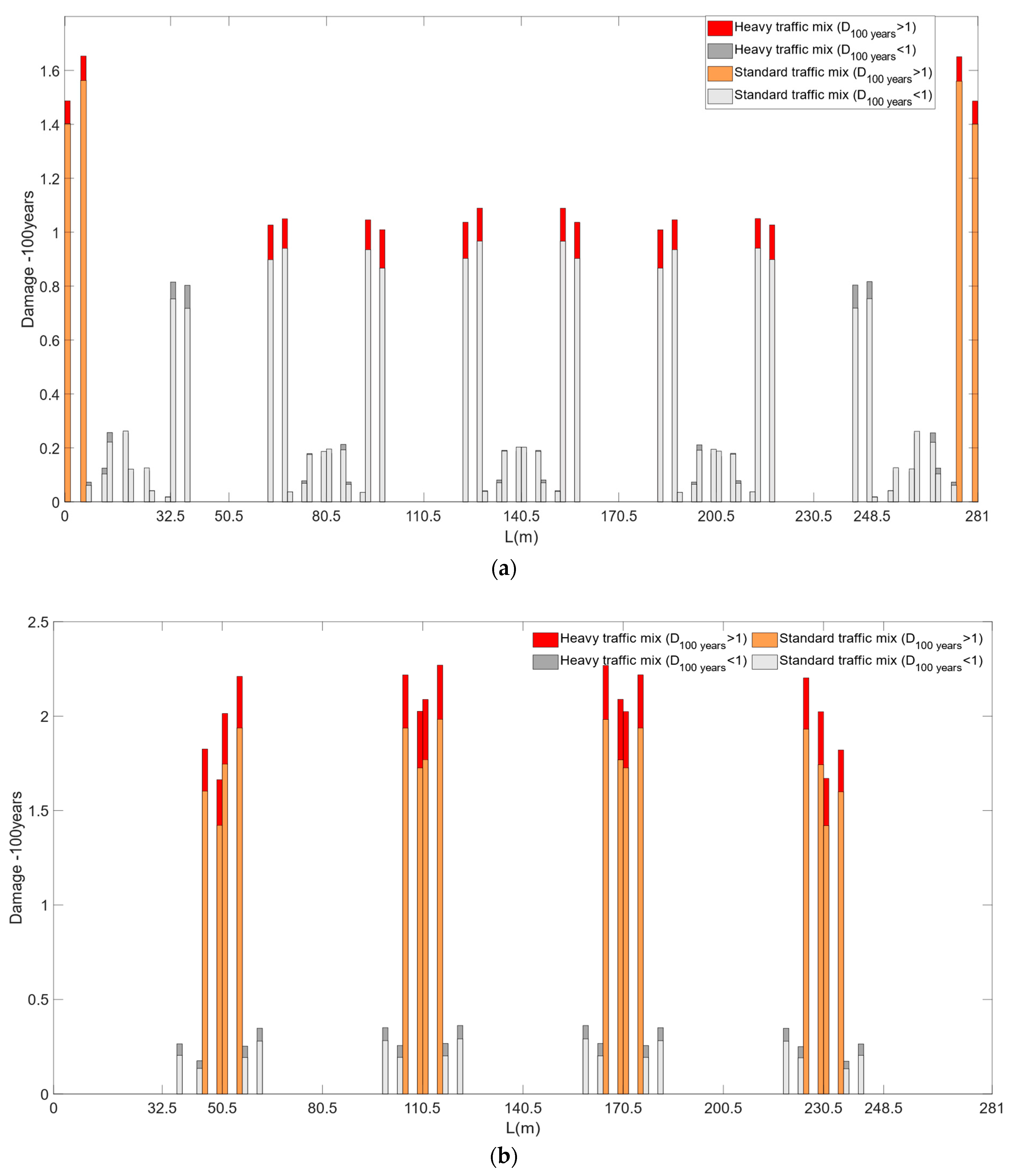

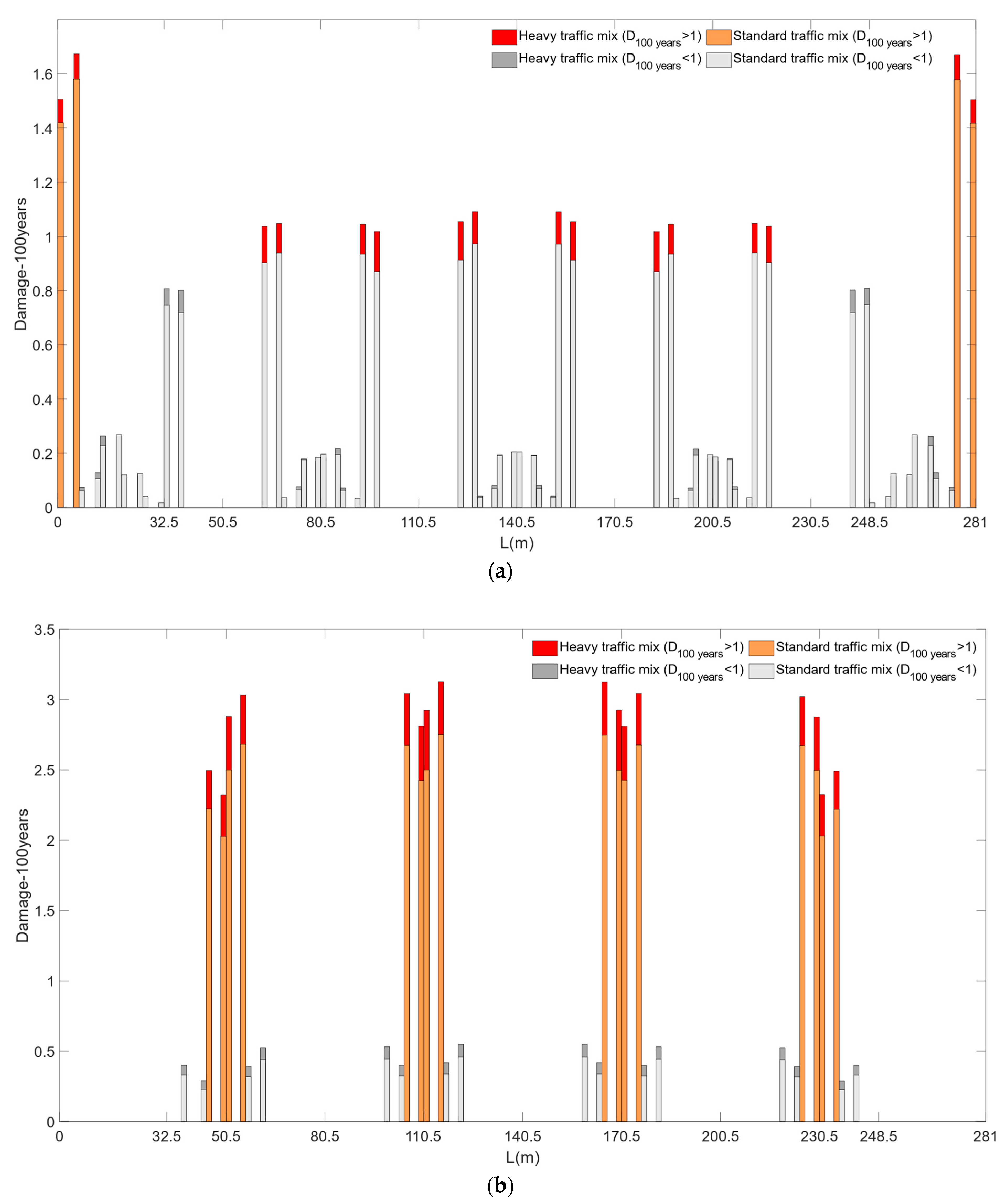


| Member | Designation of Corresponding Connection Detail in FAS | Cross Section | |
|---|---|---|---|
| Inferior flanges | sec 1 (general section) | 2 UPN400 + 13 mm flange |  |
| sec 2 (close to intermediate columns) | 2 UPN400 + 20 mm flange |  | |
| Diagonals | sec 3 (general section) | 2 UPN350 |  |
| sec 9 (close to intermediate columns) | 2 UPN400 |  | |
| Vertical posts | sec 4 (general section) | (297 × 18) × (348 × 10.5) mm |  |
| sec 10 (close to intermediate columns) | 560 × 30) × (348 × 25) mm |  | |
| Cross- girders | sec 5 | (688 × 28) × (297 × 15) mm |  |
| Superior flanges | sec 8 | 2 UPN400 + 12 mm flange |  |
| Global Mode No. | Deformation Shape | (%) |
|---|---|---|
| 1 (Transversal, yy direction) |  fnum = 2.1100 Hz | 1.627 |
 fexp = 2.129 Hz | ||
| 5 (Vertical, zz direction) |  fnum = 3.7467 Hz | |
 fexp = 3.810 Hz | ||
| 7 (Torsion, yy & zz direction) |  fnum = 4.7730 Hz | |
 fexp = 4.665 Hz |
Disclaimer/Publisher’s Note: The statements, opinions and data contained in all publications are solely those of the individual author(s) and contributor(s) and not of MDPI and/or the editor(s). MDPI and/or the editor(s) disclaim responsibility for any injury to people or property resulting from any ideas, methods, instructions or products referred to in the content. |
© 2023 by the authors. Licensee MDPI, Basel, Switzerland. This article is an open access article distributed under the terms and conditions of the Creative Commons Attribution (CC BY) license (https://creativecommons.org/licenses/by/4.0/).
Share and Cite
Nhamage, I.A.; Dang, N.-S.; Horas, C.S.; Poças Martins, J.; Matos, J.A.; Calçada, R. Performing Fatigue State Characterization in Railway Steel Bridges Using Digital Twin Models. Appl. Sci. 2023, 13, 6741. https://doi.org/10.3390/app13116741
Nhamage IA, Dang N-S, Horas CS, Poças Martins J, Matos JA, Calçada R. Performing Fatigue State Characterization in Railway Steel Bridges Using Digital Twin Models. Applied Sciences. 2023; 13(11):6741. https://doi.org/10.3390/app13116741
Chicago/Turabian StyleNhamage, Idilson A., Ngoc-Son Dang, Claúdio S. Horas, João Poças Martins, José A. Matos, and Rui Calçada. 2023. "Performing Fatigue State Characterization in Railway Steel Bridges Using Digital Twin Models" Applied Sciences 13, no. 11: 6741. https://doi.org/10.3390/app13116741
APA StyleNhamage, I. A., Dang, N.-S., Horas, C. S., Poças Martins, J., Matos, J. A., & Calçada, R. (2023). Performing Fatigue State Characterization in Railway Steel Bridges Using Digital Twin Models. Applied Sciences, 13(11), 6741. https://doi.org/10.3390/app13116741









